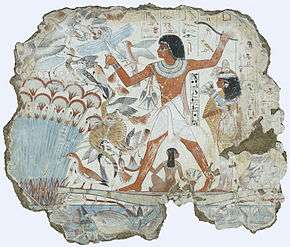Nebamun
Nebamun was a middle-ranking official "scribe and grain accountant" during the period of the New Kingdom in ancient Egypt. He is thought to have lived c. 1350 BCE and worked at the vast temple complex near Thebes (now Luxor) where the state-god Amun was worshipped. His name was translated as "My Lord is Amun", and his association with the temple, coupled with the importance of grain supplies to Egypt, meant that he was a person of considerable practical importance, though not of the highest rank.[1]
Nebamun | |
|---|---|
Detail of the head of Nebamun, from the scene Hunting in the Marshes in the tomb of Nebamun, exposed in the British Museum | |
| Born | c. 1350 BC |
| Died | c. 1350 BC |
| Occupation | Scribe and grain accountant |
| Spouse(s) | Hatshepsut |
Nebamun is known today because of the 1820 discovery of the richly-decorated Tomb of Nebamun on the west bank of the Nile at Thebes.[2] Although the exact location of that tomb is now lost, a number of wall paintings from the tomb were acquired by the British Museum where they are now on display.[2] They are considered to be one of that museum's greatest treasures.[1][3]
Gallery
 Fowling scene
Fowling scene Dancers and musicians
Dancers and musicians Pond in a Garden from the Tomb of Nebamun, Thebes
Pond in a Garden from the Tomb of Nebamun, Thebes
See also
References
- Parkinson, Richard B. (2008). The Painted Tomb Chapel of Nebamun. British Museum Press. p. 39. ISBN 9780714119793.
- Salvat, Juan (1970). Historia del arte (in Spanish). Tomo 1. Barcelona: Salvat Editores, Sociedad Anónima. p. 320. ISBN 8434532433.
- "Egyptian life and death: the tomb-chapel of Nebamun (Room 61)". British Museum. London. Retrieved 26 November 2017.
External links
- Nebamun: Illustrated description of tomb and its erotic dancers
| Wikimedia Commons has media related to Nebamun. |
